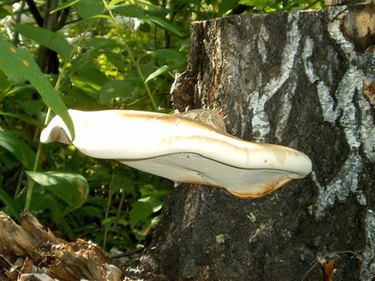
Many mushrooms prefer a particular wood for their growth because they need the nutrients and conditions that they can get from that one wood. Some form symbiotic relationships with certain trees, as the chanterelle does with birch, but many also feed on dead, decaying wood. There are also mushrooms that parasitize birch trees and which will kill weakened trees, such as the birch polypore, a shelf fungus with an interesting history.
Birch Polypore
Video of the Day
These mushrooms, Piptoporus betulinus, are found almost exclusively on birch trees. The cap grows to be between 2 inches and 8 inches in diameter, with a white, tan or gray-brown surface. The mushrooms are round but connect to the tree at a narrow point, and so they often appear horseshoe-shaped. They cause a brown rot on weakened birches and will eventually kill the tree. Because they're tough but light, folklore holds that they were once used to pack the shields of ancient Scots. They're also called "razor strop" fungus due to the mushroom's use by the Victorians, who used it to sharpen their razor blades.
Video of the Day
Fly Agaric
Amanita muscaria, or the fly agaric, is often what we think of as a "typical-looking" mushroom. Its white stem and white-spotted red or yellow cap bring to mind children's cartoons and stories, and it is considered to be one of the most photogenic mushrooms. It grows across the northern hemisphere, wherever birch and pine trees are found. It also belongs to one of the most poisonous groups of mushrooms, the Amanitas. There's debate about its hallucinogenic properties, but it is not recommended for ingestion and in fact contains several poisonous compounds.
Chanterelle
Chanterelle mushrooms, or Cantharellus cibarius, actually form symbiotic relationships with the roots of birch trees. These mushrooms have medium to large caps that are yellow or orange-yellow in color. Between ½ inch and 8 inches in size, the caps are convex when the mushroom is young and become flat as the chanterelle reaches maturity. They have a fruity odor, often compared to apricots, and the bigger the patch of chanterelles, the more noticeable this odor becomes. Chanterelles are edible and popular with cooks, having a somewhat peppery taste.
Tinder Fungus
Also known as Fomes fomentarius, tinder fungus grow on different trees depending on their location. At the north edge of its range, it grows most commonly on birch trees. It looks something like a dark gray oyster shell emerging from the trunk of a tree, and this similarity is furthered by the semicircular ridges along its surface. This inedible fungus is a parasite, feeding on the heartwood of weakened trees. Once the tree dies, the fungus becomes saprophytic, meaning that it continues to feed on the dead and decaying tree.